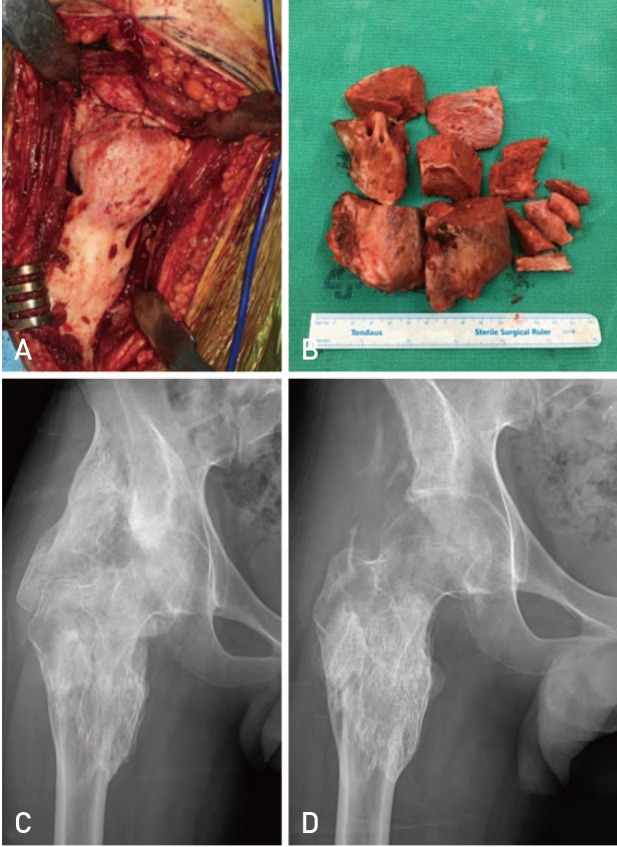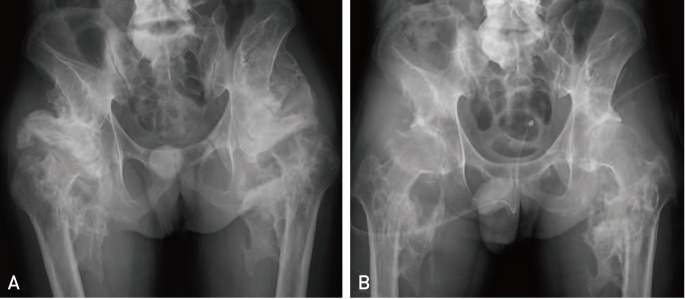Hip Pelvis.
2018 Jun;30(2):86-91. 10.5371/hp.2018.30.2.86.
Ankylosing Neurogenic Myositis Ossificans of the Hip: A Case Series and Review of Literature
- Affiliations
-
- 1Department of Orthopaedic Surgery, Inje University Seoul Paik Hospital, Inje University College of Medicine, Seoul, Korea.
- 2Department of Orthopaedic Surgery, Inje University Sanggye Paik Hospital, Inje University College of Medicine, Seoul, Korea. ybs58@paik.ac.kr
- KMID: 2412689
- DOI: http://doi.org/10.5371/hp.2018.30.2.86
Abstract
- PURPOSE
Neurogenic myositis ossificans (NMO) in patients with traumatic spinal cord or brain injuries can cause severe joint ankylosis or compromise neurovascularture. The purpose of this study was to evaluate the clinical and radiological outcomes of and review considerations relevant to surgical resection of NMO of the hip joint.
MATERIALS AND METHODS
Six patients (9 hips) underwent periarticular NMO resection between 2015 and 2017. The medical records of these patients were retrospectively reviewed. Preoperative computed tomography including angiography was performed to determine osteoma location and size. Improvement in hip motion allowing sitting was considered the sole indicator of a successful surgery. The anterior approach was used in all patients. The ranges of motion (ROM) before and after surgery were compared.
RESULTS
The mean time from accident to surgery was 3.6 years. Average ROM improved from 24.3°(flexion and extension) to 98.5°(flexion and extension) after surgery, and improvement was maintained at the last follow-up. No commom complications (e.g., deep infection, severe hematoma, deep vein thrombosis) occurred in any patient. Improvement in ROM in one hip in which surgical resection was performed 10 years after the accident was not satisfactory owing to the pathologic changes in the joint.
CONCLUSION
Surgical excision of periarticular NMO of the hip joint can yield satisfactory results, provided that appropriate preoperative evaluation is performed. Early surgical intervention yields satisfactory results and may prevent the development of intra-articular pathology.
MeSH Terms
Figure
Reference
-
1. Sakellariou VI, Grigoriou E, Mavrogenis AF, Soucacos PN, Papagelopoulos PJ. Heterotopic ossification following traumatic brain injury and spinal cord injury: insight into the etiology and pathophysiology. J Musculoskelet Neuronal Interact. 2012; 12:230–240. PMID: 23196266.2. van Kuijk AA, Geurts AC, van Kuppevelt HJ. Neurogenic heterotopic ossification in spinal cord injury. Spinal Cord. 2002; 40:313–326. PMID: 12080459.
Article3. Garland DE. A clinical perspective on common forms of acquired heterotopic ossification. Clin Orthop Relat Res. 1991; (263):13–29. PMID: 1899635.
Article4. Garland DE. Clinical observations on fractures and heterotopic ossification in the spinal cord and traumatic brain injured populations. Clin Orthop Relat Res. 1988; (233):86–101.
Article5. Genet F, Marmorat JL, Lautridou C, Schnitzler A, Mailhan L, Denormandie P. Impact of late surgical intervention on heterotopic ossification of the hip after traumatic neurological injury. J Bone Joint Surg Br. 2009; 91:1493–1498. PMID: 19880896.
Article6. Denormandie P, de l'Escalopier N, Gatin L, Grelier A, Genêt F. Resection of neurogenic heterotopic ossification (NHO) of the hip. Orthop Traumatol Surg Res. 2018; 104:S121–S127. PMID: 29174871.
Article7. Mayson TA, Ward V, Davies KR, et al. Reliability of retrospective assignment of gross motor function classification system scores. Dev Neurorehabil. 2013; 16:207–209. PMID: 23323825.
Article8. Garland DE. Surgical approaches for resection of heterotopic ossification in traumatic brain-injured adults. Clin Orthop Relat Res. 1991; (263):59–70. PMID: 1899638.
Article9. Baird EO, Kang QK. Prophylaxis of heterotopic ossification - an updated review. J Orthop Surg Res. 2009; 4:12. PMID: 19379483.
Article10. McCormick A, Brien M, Plourde J, Wood E, Rosenbaum P, McLean J. Stability of the Gross Motor Function Classification System in adults with cerebral palsy. Dev Med Child Neurol. 2007; 49:265–269. PMID: 17376136.
Article11. Bidner SM, Rubins IM, Desjardins JV, Zukor DJ, Goltzman D. Evidence for a humoral mechanism for enhanced osteogenesis after head injury. J Bone Joint Surg Am. 1990; 72:1144–1149. PMID: 2398084.
Article12. Gautschi OP, Toffoli AM, Joesbury KA, Skirving AP, Filgueira L, Zellweger R. Osteoinductive effect of cerebrospinal fluid from brain-injured patients. J Neurotrauma. 2007; 24:154–162. PMID: 17263679.
Article13. Kantak AP, Shah NN. Extensive surgical wound lavage reduces the incidence and severity of heterotopic ossification in primary total hip replacement: a study of 175 hip replacements. Hip Pelvis. 2017; 29:234–239. PMID: 29250497.
Article14. Shehab D, Elgazzar AH, Collier BD. Heterotopic ossification. J Nucl Med. 2002; 43:346–353. PMID: 11884494.15. Hata K, Takahata Y, Murakami T, Nishimura R. Transcriptional network controlling endochondral ossification. J Bone Metab. 2017; 24:75–82. PMID: 28642850.
Article16. Kim JS, Yoon SS, Kim YH, Ryu JS. Serial measurement of interleukin-6, transforming growth factor-beta, and S-100 protein in patients with acute stroke. Stroke. 1996; 27:1553–1557. PMID: 8784129.17. Takeda S, Elefteriou F, Levasseur R, et al. Leptin regulates bone formation via the sympathetic nervous system. Cell. 2002; 111:305–317. PMID: 12419242.
Article18. Wang L, Tang X, Zhang H, Yuan J, Ding H, Wei Y. Elevated leptin expression in rat model of traumatic spinal cord injury and femoral fracture. J Spinal Cord Med. 2011; 34:501–509. PMID: 22118258.
Article19. Mitchell EJ, Canter J, Norris P, Jenkins J, Morris J. The genetics of heterotopic ossification: insight into the bone remodeling pathway. J Orthop Trauma. 2010; 24:530–533. PMID: 20736788.
Article20. Banovac K, Williams JM, Patrick LD, Levi A. Prevention of heterotopic ossification after spinal cord injury with COX-2 selective inhibitor (rofecoxib). Spinal Cord. 2004; 42:707–710. PMID: 15179440.
Article21. Vanden Bossche L, Vanderstraeten G. Heterotopic ossification: a review. J Rehabil Med. 2005; 37:129–136. PMID: 16040468.
Article22. Wu XB, Yang MH, Zhu SW, et al. Surgical resection of severe heterotopic ossification after open reduction and internal fixation of acetabular fractures: a case series of 18 patients. Injury. 2014; 45:1604–1610. PMID: 24917211.
Article23. Wick L, Berger M, Knecht H, Glücker T, Ledermann HP. Magnetic resonance signal alterations in the acute onset of heterotopic ossification in patients with spinal cord injury. Eur Radiol. 2005; 15:1867–1875. PMID: 15856244.
Article24. Campbell TM, Reilly K, Laneuville O, Uhthoff H, Trudel G. Bone replaces articular cartilage in the rat knee joint after prolonged immobilization. Bone. 2018; 106:42–51. PMID: 28974461.
Article25. Stover SL, Niemann KM, Tulloss JR. Experience with surgical resection of heterotopic bone in spinal cord injury patients. Clin Orthop Relat Res. 1991; (263):71–77.
Article26. Nomura M, Sakitani N, Iwasawa H, et al. Thinning of articular cartilage after joint unloading or immobilization. An experimental investigation of the pathogenesis in mice. Osteoarthritis Cartilage. 2017; 25:727–736. PMID: 27916560.
Article27. Law-Ye B, Hangard C, Felter A, et al. Pre-surgical CT-assessment of neurogenic myositis ossificans of the hip and risk factors of recurrence: a series of 101 consecutive patients. BMC Musculoskelet Disord. 2016; 17:433. PMID: 27756329.



